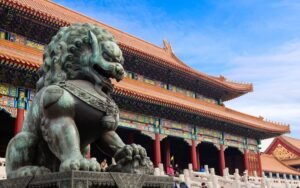Table of Contents
ToggleIntroduction
The Chinese language is rich with grammatical particles that give nuance and depth to its sentences, one of which is the often-used ‘着 (zhe)’. To the student of Mandarin, ‘着 (zhe)’ presents a unique challenge due to its multifaceted uses and subtle meanings. This article delves into the role of ‘着 (zhe)’ in expressing sequential actions, which is a critical aspect of achieving fluency in Chinese.
Understanding ‘着 (zhe)’
‘着 (zhe)’ is a particle in Chinese grammar that primarily indicates a continuous state or an action in progress, similar to the English -ing form. However, regarding sequential actions, ‘着 (zhe)’ has a specific function. It shows that an action is carried out in the background or continues while another action takes place. This is distinct from the simple continuation of an action and is about setting a scene or context within which something else occurs.
Sequential Actions with ‘着 (zhe)’
Sequential actions in Chinese are often expressed through a combination of verbs, with ‘着 (zhe)’ appended to the verb that denotes the ongoing background action. The structure usually follows a pattern where the first verb + ‘着’ sets the scene, and the following verb(s) indicate the subsequent action(s).
- 他边跑边听着音乐。(Tā biān pǎo biān tīngzhe yīnyuè.)
- “He is running while listening to music.”
In this sentence, ‘听着 (tīngzhe)’ implies that listening to music is what the subject is continuously doing while performing another action, which is running.
Nuances of ‘着 (zhe)’
The use of ‘着 (zhe)’ is nuanced. It does not merely indicate simultaneity; it emphasizes that the action it attaches to is secondary to the main action or is meant to provide additional context. It’s important to note that not all ongoing actions can take ‘着 (zhe).’ The choice of whether to use ‘着 (zhe)’ can depend on factors such as the nature of the action, the focus of the sentence, or the speaker’s intent.
Common Pitfalls and Confusions
Learners may confuse ‘着 (zhe)’ with other aspect particles like ‘了 (le)’ and ‘过 (guò),’ which also relate to the completion and experience of actions but do not serve the same purpose. ‘了 (le)’ indicates a state change or a completed action, while ‘过 (guò)’ denotes an experiential aspect, meaning that someone has had the experience of doing something. ‘着 (zhe),’ on the other hand, emphasizes an action’s ongoing state when another action occurs.
Example Sentences
To illustrate further, consider the following examples:
- 她穿着红衣服在跳舞。(Tā chuānzhe hóng yīfú zài tiàowǔ.)
- “She is dancing in a red dress.”
Here, ‘穿着 (chuānzhe)’ indicates that wearing the red dress is the continuous state of dancing.
- 我站着等你。(Wǒ zhànzhe děng nǐ.)
- “I will stand waiting for you.”
‘站着 (zhànzhe)’ suggests that the speaker will stand while waiting, which is the secondary action.
Conclusion
‘着 (zhe)’ is a versatile and essential particle in Chinese grammar, especially when expressing sequential or simultaneous actions. Understanding and correctly using ‘着 (zhe)’ can significantly enhance the clarity and expressiveness of one’s Mandarin. For learners, mastering the subtleties of ‘着 (zhe)’ is a step toward a deeper comprehension of the complexities inherent in Chinese syntax and an opportunity to communicate with greater precision and authenticity.
FAQs
Q: What is the primary function of ‘着 (zhe)’ in Chinese grammar?
A: The primary function of ‘着 (zhe)’ is to denote a continuous state or an ongoing action, similar to the English “-ing” ending. It indicates that an action is happening concurrently with the main action or as a background context for another action.
Q: Can ‘着 (zhe)’ be used with any verb to indicate ongoing action?
A: Not all verbs can be used with ‘着 (zhe)’ to indicate ongoing action. The verb must be able to continue over time logically. It is not used with stative verbs or actions that are instantaneous.
Q: How is ‘着 (zhe)’ used to express sequential actions?
A: In expressing sequential actions, ‘着 (zhe)’ is attached to the verb describing the ongoing background action, while another describes the main action. This structure sets the scene or provides context for the main action.
Q: How does ‘着 (zhe)’ differ from ‘了 (le)’ and ‘过 (guò)’?
A: ‘了 (le)’ indicates a completed action or a change of state, and ‘过 (guò)’ denotes someone has experience of doing something. ‘着 (zhe),’ however, emphasizes the ongoing nature of an action in the background of another action or as a continuous state.
Q: Can ‘着 (zhe)’ indicate the simultaneity of actions?
A: Yes, ‘着 (zhe)’ can indicate that two actions co-occur, with the ‘着 (zhe)’ action providing context or background to the primary action.
Q: Is ‘着 (zhe)’ used in spoken and written Chinese?
A: Yes, ‘着 (zhe)’ is used in spoken and written Chinese, but its usage may vary slightly based on formality and context.
Q: Are there any common mistakes learners should make when using ‘着 (zhe)’?
A: A common mistake is overusing ‘着 (zhe)’ with verbs where it’s not appropriate or confusing ‘着 (zhe)’ with ‘了 (le)’ or ‘过 (guò).’ Another mistake is not considering the logical sequence of actions when using ‘着 (zhe)’ to set the background action.
Q: Can you give an example of a sentence with ‘着 (zhe)’ that illustrates its proper use?
A: Sure, for instance: “他戴着帽子走进了房间。” (Tā dàizhe màozi zǒu jìn le fángjiān.) – “He walked into the room wearing a hat.” Here, ‘戴着 (dàizhe)’ indicates the continuous state of wearing a hat as walking into the room occurs.
Contact our head teacher, Chen Huimin, at info@lcchineseschool.com if you want to learn Chinese or have additional questions about our Chinese programs.
Sign up for a free trial class here.
Learn about our Internship Program in China.
Get free Chinese learning resources.
Learn about China’s 2024 Offical Holiday Schedule







